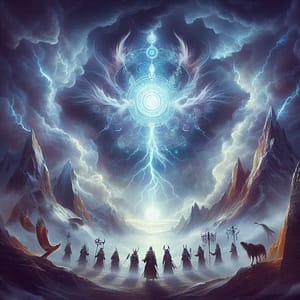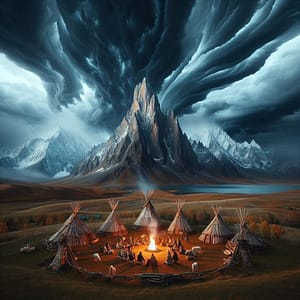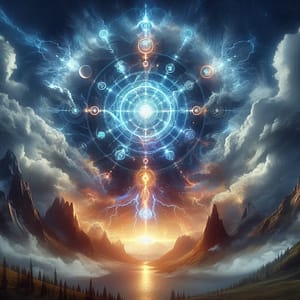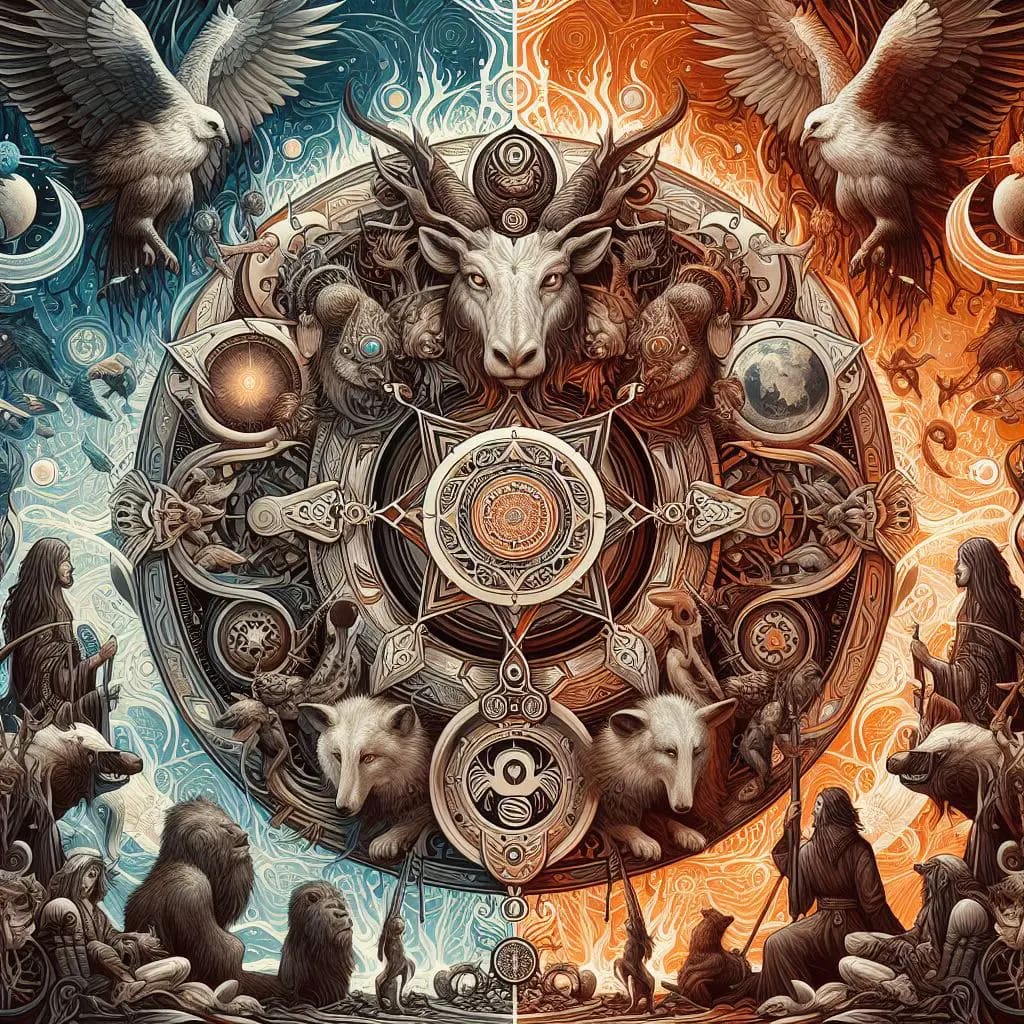Turkish Mythology
Turkic mythology is a mythological whole believed by the historical Turkic peoples. The ancient legends are full of social and cultural themes rather than elements of Tengricism, the ancient common belief of the Turkic peoples. Some of them were later modified with Islamic elements. The original works of the Dede Korkut epics, considered one of the oldest literary documents in the world, are in the Vatican and Dresden libraries. It bears similarities with the mythology of the Aegean and Anatolian civilizations.
According to many researchers, Turkic mythology has evolved from a monotheistic basis, as in Tengricism, to a polytheistic form over time. In addition, Zoroastrianism, Mani religions and Buddhism, with which historical Turkic peoples came into contact, also bear traces of Turkic mythology. Therefore, instead of a general definition of Turkic mythology, it may be more accurate to say "Turkic Mythologies", taking into account the different elements in the belief."
Religious Beliefs of Turks
They called their religion "Nom", the first root of the Arabic words "Namus" and "An-Nawâmis-i İlâhiye". This word, which was translated into Greek as "Numus - Havus", meant infinite power and will, and was used as the equivalent of the word "God" in Sanskrit. The Turks called their spiritual leaders "Tuyun/Tuyon" and their seers and magicians "Kam". In addition, their religious books were called "Nom" and their spiritual leaders were called "Nomis". Under the influence of Islam, Oghuzs called their kam "Ozan".
The word "shaman" was a term used through Europeans. Shamans combined three different professions in society: doctor, sorcerer and soothsayer. According to Turkish thinker Ziya Gökalp, the correct name for the ancient religion of the Turks should have been "Tuyonism". According to Gökalp, although the religion of the Turks was initially perceived as "Naturalism", it was actually a "Symbolism" in which words and symbols with hidden meanings were worshipped. In this belief system, which spread among different societies, a distinction is made between religion and magic, with "Shamanism" derived from animism on the one hand and "Tuyonism", which controls the gods and the universe, on the other.
Belief in a dual God
Two great gods were believed in, the supreme god "Kayra Khan" who ruled the universe at the highest level of the sky and the god of evil "Erlik" who ruled the underworld. A number of other gods were also believed in, called "Earth - Water Deities", who maintained the order of the earth and ruled all Turkish tribes.
Turkish cosmogony
"Altai Turks" believed that the sky consisted of seventeen layers and that the top layer was inhabited by "Kayra Khan", the father of all gods. Three different gods emerged from this god. The first of these gods was "Ulgen" who sat on a golden throne on the sixteenth layer of the sky. The second was "Kizagan" who lived on the ninth layer and the third was "Mergen" who made the seventh layer his home. Also living in this layer was the "Moon Ancestor" called "Mother Day" who illuminated the earth and the sky. The fifth layer was inhabited by "Katay Khan", who was called the "Creator of Creators".
Other
In Turkish mythology, Sky God is the original creative force, father of Kayra Khan. The demon Erlik Khan is the ruler of the underworld. Ulgen sits on the 16th floor of the sky and is the son of Kayra Khan.[6] "Barak Ata" is the name given in Mongolian and Turkic mythology to the dog-headed creature from which the Mongols are supposed to have descended, also known as "Nokay Eçege". "Umay" symbolizes fertility and abundance. She has three horns, is dressed in white and chooses the children to be born. Ulgen, Umay and Barak Ata were later deified. Kuyash symbolizes the idea of the sun god in Turkish societies. Maygil is the god of the waters. Elbis is the god of war
Mysticism
Shamanism, which traces its roots back to Central Asian Shamanism, is a common "magical religion" system that is widespread among many Turkic-Mongolian tribes, even Lapps and Eskimos, living over a wide area from Greenland to Eastern Siberia. It is still active in areas where Islam and Christianity have not fully penetrated, and even in areas where these belief systems have entered later, this religion continues to exist in a secondary role. Despite the spread of religious influences such as Buddhism, Manichaeism, Islam and Christianity among Turks since the eighth century, Shamanism has not lost much of its power due to its ability to incorporate foreign beliefs. For this reason, Shamanism can also be called "Turkish paganism".
One of the most prominent features of Shamanism is an enriched "Polytheism" aspect of the celestial strata, the afterlife and the realm of gods. Shamanism also retains the richness of Naturalism, which emphasizes living in harmony with nature. Traces of Turkic mysticism, in the form of magic and religion, can also be found in the Turkic beliefs reviewed below:
The Yakuts have a vague idea of man's fate after death. They have no idea of heaven and hell, and their view of life after death consists of "réel - she'ni" and special elements, as in Greek or Arab mythology. Many of them do not think about the afterlife.
Like all Animists, Yakuts believe that spirits roam the ancient lands and can haunt people. Their understanding of spirits is based entirely on the concept of material and special things. Spirits are beings separate from human beings, with weight and space. They have sometimes friendly and sometimes hostile relations with humans.
Shamans
Shamans spend their lives alone, usually in caves and secret cells, and are people who have abilities in magic and health and who assume the role of "witchdoctor" in society. They claim to be able to communicate with invisible spirits and demonstrate these abilities through trembling, fainting and ecstasy. They acquire these abilities through long and exhausting religious rituals.
During the rituals, the shamans become ecstatic, fizzing, blackening and spinning until exhaustion, eventually losing all contact with things and the real universe. This task is considered a hereditary talent among the Samoyeds and Khanty, while in other societies, such as the Tungus, Yakuts and Altais, it is considered a half-hereditary, half-acquired quality.
The term "Shaman", used for "illuminated men" or "seers" who act as ambassadors between the lower and upper worlds, takes different names in different regions. These Shamans are called "Soyok" among Siberian Turks, "Angakok" among Eskimos, "Noïde" among Lapps, "Tadibca" among Samoyets, and "Kam" among some other Turkic tribes. After the adoption of Islam, the Oghuz called their kam "Ozan". Distinguished from other people by their supernatural abilities and their relationship with the natural world and endowed with a high state of mind, Shamans are obliged to be present at general and votive sacrifice ceremonies.
Rituals
The institution of shamanism, sometimes inherited and sometimes acquired, performed rituals involving a complex set of rules. Shamans were not only magicians and diviners, but also doctors who treated diseases. Among the Turks, there was also a class called "Herbalists" and "Atasagon", who cured diseases with material treatment methods. Shamans danced to poetry and music, wore special ceremonial dress and various rattles. These rituals, which were not attended by women, were usually held in yurts set up in a forest full of "Pleasant Trees". "Neurotic men" who were originally afflicted with nervous diseases, very similar to the sheikhs of the sect called "Üveysî", were the most talented people for vehbî Shamanism. There is a complete similarity between vehbî Shamanism and the belief in the healing abilities of all family members of some families, still called "Airplanes" today.
It is impossible for anyone other than the kams to understand the prayers made in a state of ecstasy during the rituals. During the ecstatic rituals, which are like "Miraj" for the Shamans, the Shamans fall into a state of complete "divine intoxication" and sometimes even die as a result of the excessive excesses that occur during these rituals. The communication of shamans with the upper realms in a state of ecstasy and ecstasy is reminiscent of the Mysteries of Elefsis in Ancient Greece. Like these Ancient Greek mysteries, which are considered to be the foundation of Mediterranean mysticism, the "Miraj Rites" of the Shamans formed the basic building block in the development of Central Asian mysticism. During the ritual, the most important tool that increases the transcendence is the drum. On the drums, images of the animals and boats that took the Shamans to the sky and images of the gods were painted. The similarity between the animal called "Barak" by the Shamans and "Burak", the animal of Miraj in Islam, is noteworthy. After the adoption of Islam, Turks continued to paint similar images in their miniatures of the Miraj event.
Shamanism according to Eastern sources
In Islamic sources, Shamanism is referred to as "Shamaniyya" (Semenniyya). Ibn al-Nedim in his book Al-Fihrist states that the majority of the people of Maveraunnehir belonged to the Semeniyya religion. More detailed information is given in Al-Biruni's "Kitâb-ı Malil'Hind". In this book, it is stated that Buddhism, which he refers to as "Budasef", originated in India and was preceded by the religion of "Shamanism". The Khorasanians called their religion "Shemenan". Before the adoption of Buddhism, the official religion of Genghis Khan was Shamanism and the Kams had great influence there. According to Qazvinī, the "Cem" ritual originated from primitive "Shamanism" and "Kam" ceremonies. There are some similarities between the primitive mysticism of Shamanism and the primitive mysticism of Anatolian sects and orders. For example, the "Owner and Musâhip Ceremony" in Kızılbaşs is a continuation of the "Dühûl" ceremony in primitive communities.
According to the Menâkıbi of Imâm Ja'far, "If the tâlib hides his sin, he is a kezzâp in Tarikât-i-Aliyya. He becomes a traitor of the path and a traitor of faith. O brother, do not hide your sin and tell your problem. Don't put it in the dark grave, say it here." The three types of spirits recognized by Alevis are reminiscent of the spirits called "Isshi," "Cor" and "Kut" by the Yakuts. According to Alevi beliefs, mountains, hills and forests where dwellings are located are sacred. In ancient Bashkirs, things like wind, trees, mountains and rivers were considered as gods. Some of the Bashkir worshiped fish, cranes, while others worshiped pieces of wood. Today, the bear is considered a sacred animal in Siberian Shamanism. Similarly, in Anatolian Alevism, the tree and the bear are considered sacred. Anatolian Alevism has been influenced by ancient Anatolian society, Islam and ancient Iran. Rituals such as the "Divan of Pir", the "Cem ritual" and the "Square of Erenler" are the result of these mystical influences and cannot be directly compared to "Shamanism". All these comparisons show that the primitive mysticism present in ancient Turkic religion survived after Islam in the form of secret sects and cults. Bedr'ed-Dîn Mahmud Aynî provides detailed information about the "Kamlars" and some Alevi fathers such as "Aybek Baba," "Burak Baba" and "Geyikli Baba" that will help to make comparisons.
The Oldest Remains
The oldest remnants of Turkic mythology can only be proved by the written documents of other peoples. The most important evidence is found in ancient Chinese writings. For example, a writing from 330 BC contains the epic of Asena, one of the most important legends of Turkic mythology.

Well-known epics
Gokbörü Epic
It is one of the oldest known Turkic legends and has an important place in Turkic mythology. This epic is widespread in various forms among all Turkic peoples and has left a deep mark on Turkic culture.
According to legend, the Turks were almost completely wiped out by the attack of their enemies. However, only two children survive this attack. Tengri sends a sacred she-wolf to protect these children. The wolf feeds, raises and protects the children. After a while, the wolf conceives a child and gives birth to ten cubs. These ten cubs are the rulers of the future Turkic communities.
Gökbörü Epic tells the story of the difficult times the Turks' ancestors lived through, their endurance and their belief in the future. At the same time, the sacredness of the bozkurt and the important values it represents for the Turkic communities are also emphasized in this epic. This epic is an important part of Turkish mythology and culture and is considered a symbol of the identity of the Turkish people.
Ergenekon saga
After suffering a great defeat, the Turks packed up their tents and migrated. A sacred wolf sent by Tengri guides the Turks and leads them to a large plain surrounded by mountains and fertile land. After a few generations, the Turks outgrow this plain. This time a wolf shows them that one of the surrounding mountains is made of ore and the blacksmiths melt it down. The people come out of the plain and announce to all the steppe peoples that they have once again taken the sovereignty of the steppes.
Oghuz Saga
This epic tells the life of Oghuz Khan, known as the ancestor of the Turks. From his birth to his death and the division of the state to his sons, the epic also includes Oguz's meeting with his wives, the birth of his sons and the wars.
Manas Epic
The Manas epic, the world's longest epic, tells the story of Kyrgyz Manas, who was known from an early age to be a hero. It is said that Manas was betrayed and killed by his friends. The animals crying over his grave lament Manas, and the God of Heaven takes pity on Manas and resurrects him. Manas goes after his friends who betrayed him.
Legends about the origin of the Turks
One of the most important features of Turkic mythology is that each tribe has a personal origin myth, no matter how small. For example, in the Oghuzname, each tribe mentioned in the Oghuzname is first told its origin myth.
The most important and well-known legend is the common Turkic epic of descent. This legend is known in almost every Turkic community and tells that the earliest Turkic rulers descended from the mating of a wolf sent by Tengri. Some versions tell of a she-wolf mating with a son of the last Turk, while other versions tell of Sky God mating with the ruler's daughter in the guise of a male wolf.
Another well-known origin myth is the origin myth of the Kyrgyz people. According to this legend, forty girls conceived from the water of a sacred lake formed the first Kyrgyz.
Traces of Turkish mythology in Europe
The influence of the ancient Turkic peoples who migrated to Europe has left traces in European mythology and culture. In particular, communities of Turkic origin, such as the Huns and Pre-Bulgarians, have become an important element of European mythology.
One of the most famous epics of German mythology is the saga of the German hero Siegfried, who fought against the Huns and dragons. In this epic, Attila's name is mentioned as "Etzel". The Pre-Bulgarians also left a deep mark on Bulgarian mythology with the epic of Khan Asparuh (Isbara Khan), which they brought to the Balkans. This epic is a work that is taught from the first grade in Bulgaria and memorized by every Bulgarian child. During the spring festival "March enizi", brought by the pre-Bulgarians, primary school children reenact parts of the Khan Asparuh saga.
Hungarian mythology also includes a long history of Attila the Hun and ancient Turkish epics. Prof. Sven Laagarbring has stated that Turks also play an important role in Swedish mythology. Laagarbring claims that Oden's companions were actually Turks and relies on various documents. Johan Ihre, who analyzed the similarities between Swedish and Turkish, argued that Oden and his companions were of Turkish origin.
All these examples show that European mythology and culture have been influenced by communities of Turkish origin and that Turkish mythology has spread to Europe. These interactions are the result of contacts and cultural exchanges between different cultures throughout history.
Buddhist Turkish mythology
In the 9th century, the Uighur Turks accepted the religion of Buddhism and developed the first great settled Turkish culture on the basis of this religion. It is known that Uighur monks translated thousands of Buddhist writings from Sanskrit and Chinese into Turkish during this period. Among them, many foreign legends were also translated into Turkish, but ancient Turkish epics and history were also written down. In the city of Khotan they built the largest library of its time, but it was completely burned down in an attack by the Kyrgyz. Only small fragments of pages have survived, but the page numbers on some of these fragments (pages 500-page 600) prove how extensive and detailed these books were.
Among these few remnants are legends designed to recruit new monks to the monasteries. One, for example, tells a horrible story to emphasize that material life is evil and disgusting (Old Turkish):
körüp thin sakıntı. Bo menin yutuzum bo tep entered into the interior and lay down with ulug birle... For the sake of eating esrökin biligsizin, the dead man was kucup and drove uluvsuz bilig and joined the dead man, and when he shrunk, the dead man was split... the blood in the flesh of the dead man was poured out... eating ol tözün är kamag özi tonı baştan adakka tegü kanka irinke örgenip uvutsuz biligin üçün esrükin ögsüz bolup könülina anıg ögrünçülük boltum tep sakıntı... ançagınçagan tomorrow yarudı kün tugdı... Then he determined that the manradi of the great Korkuti ulug had moved to the tul tonka and had been carrying it to the tul tonka, and he could only vomit, but he could only vomit.... a tosh was in vain... then he had gone to the head of that tosh himself.
In the story excerpted above, a desperate man who has lost his wife drinks until he is so drunk with grief that he goes to his dead wife's grave, opens it and has sexual intercourse with her corpse. He makes love to the corpse so violently that the decomposed body begins to crack in his arms. The man is covered from head to toe in putrid blood and pus. Finally the day dawns, the man looks up and sees that he is lying in the grave next to his wife's corpse and blood is pouring out of the corpse. He sees himself, covered in blood and pus. Suddenly he realizes the monstrosity he has committed, he is disgusted with himself, he begins to tear his clothes, he is filled with fear and panic. The man comes out of the grave and starts running. He cries loudly and vomits. As is often the case in Buddhist stories of this type, the man eventually goes to a monastery and dedicates his life to the Buddha, away from the material world
Deer Hunting
Some stories deal with the reincarnation of the Buddha in other bodies. In one story, a deranged Indian ruler goes hunting with hundreds of his men and kills thousands of gazelles. The head of the gazelles, a golden gazelle, is the reincarnation of Buddha. The golden gazelle warns the ruler and commands him to stop taking lives, but he does not listen. The golden gazelle finally punishes them all severely.
Siberian Turkic mythology
The Turkic peoples of Siberia have preserved the Turkic mythology in a vivid and colorful way. These peoples, who still worship the sacred beings of Tengricism and keep alive the ancient Turkic epic tradition, maintain a strong mythology.
For example, dwindling peoples such as the Dolgans have an ancient mythology. The Dolgans, who live in the north of Siberia, sometimes find mammoth corpses under the ice dating back 10,000 years during their nomadic life. The Dolgans believe that Erlik Khan, the lord of the underworld, took the mammoths underground and used them as servants. According to them, mammoths are prisoners in the underworld and if they try to come to the surface, they are immediately punished with ice. The Dolgans confirm this belief when they see the mammoths half-buried and frozen, although they do not see them alive.
The Altaians, Yakuts and other Siberian Turks also attribute many of the events of their lives to good and evil spirits and holy beings. They pray and offer sacrifices to maintain good relations with these spirits and beings, thus trying to ensure that fertility is not interrupted. In this way, the Turkic peoples of Siberia keep the tradition alive by living and transmitting their mythological beliefs.

Mythology of Anatolian Turks
During the migration of Turks to Anatolia, many epics and stories came with them from Central Asia. In the 11th century, in the Akkoyunlu state, the stories told by the newly arrived Turkish tribes were written down by an unknown author as "Dede Korkut tales". However, many myths existed in this geography before the Turks arrived in Anatolia and these myths left their mark on the mythology of Anatolian Turks.
For example, an ancient Greek legend about Pamukkale is still told today. According to this legend, an outcast girl, fed up with life, decides to commit suicide and jumps from one of Pamukkale's hills. However, she lands on a terrace full of water. A prince sees this while hunting and quickly catches up with the girl. When he looks at her, he realizes that the water has made her beautiful. Eventually the prince and the girl get married and live a happy life. This legend has contributed to the mythological richness of Anatolia.
Source
^ Turko-Mongol History, Volume 2, Page 49, Dökini translation.
^ Havz'ûl-Hayât. [In India, this word is pronounced in a special way in the prayers of the members of the profession called "Fakirs"].
^ Ala'ed-Dīn al-Juwaynī, Jahan-Kūshā.
^ Ziya Gökalp, History of Turkish Civilization, Page 25.
^ Ziya Gökalp, Eski Türkler'de din, Dar'ül-Fünun Edebiyat Fakültesi mecmuaları, Sayı 5, Rûmi 1332.
^ Çoban, Ramazan Volkan. (2013). The Place, Depiction and Origin of Ulgen, the God of Goodness in Turkish Mythology. Science and Culture, 1, 192-198. Archived January 15, 2020 at the Wayback Machine.
^ J. A. Mac. Culloch, Shamanism, Encyclopedia of Religion and Ethnic, James Hastings.
^ Gök Alp, Ziya, Social organization in the ancient Turks.
^ Radlof, Aus Sibérian, Vol. 2. (The Greek boat crossing a fiery river, the Serbére, and the myths of the other world are free from symbolism and are purely real. The descriptions of Paradise in the Holy Qur'an are of the same nature. At the beginning of his Varidat, Bedreddin Simavî writes: "Umur-û Âhiret is not as the ignorant people think; it is the realm of emr, the realm of unseen, that is, the realm of angelût. Paradise, Hell, kusûr, enhar,... and similar things are not confined to the physical realm." - Musa Kâzım Efendi translation).
^ In addition to this phenomenon of wandering spirits, there is also the idea of tenasüh, which can be likened to the mysteries of the "Arya" religions.
^ Prof. Dumezil: Notes on the History of Religions, Page 239, 1928.
^ Hilmi Ziya, Anadolu da dinî ruhiyat müşahedeleri (Mihrap mecmuaları).
^ Türkîyat Mecmuası, Volume 2, Page 520.
^ Magnien, Victor, Les mystéres d'Eleusis-Pocyat, 1929.
^ This similarity was first recognized by Ziya Gök Alp. "Sphinx" meaning winged lion is also worth mentioning here.
^ Prof. Dumezil: Notes on the History of Religions, Pages 238-240, 1928. (This is seen, for example, in the pictures of the "mysteries of the cellar").
^ Ibn Nedim, Fihrist, [Köprülü Library, No: 1134.]
^ Abu Reyhan al-Biruni, Kitâb-û-Malil-Hind.
^ Sierozevski: Shamanism in the Yakuts - Revue d'historie des Religions, 1900-1901.
^ Qazvinî, Asar-ul'Bilâd, H. 394.
^ Yusuf Ziya, İlâhiyat Fakültesi Mecmuaları, 1927-1928.
^ Imâm Jâ'fer Menâqibi. (Ankara Umûmî Kütüphânesi, Tasavvuf. No: 86; quoted by Yusuf Ziya).
^ Ibn Fadlan, Ahmad Ibn Fadlan Seyahatnâmesi.
^ Yakut-û Hamawî, Mu'jam-û Buldan, Volume 2, Page 38.
^ Mahmud-ul-Aynî, Iqd-ul'Jumman.
^ Hüseyin Hüsamettin Efendi Amas'ya Tarihi.
^ "Turkish Ancestors of the Scandinavians". Research article,Director Tekin Gün. Mootol,Culture Art.December 26, 2010. Archived from the source on August 10, 2020.




